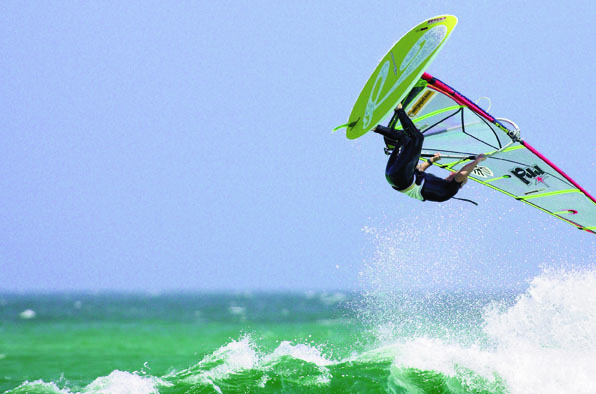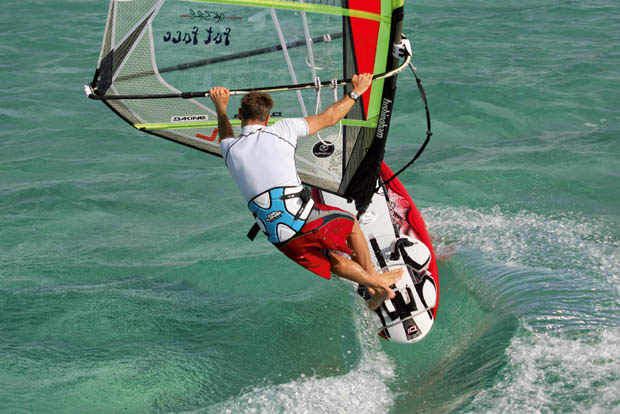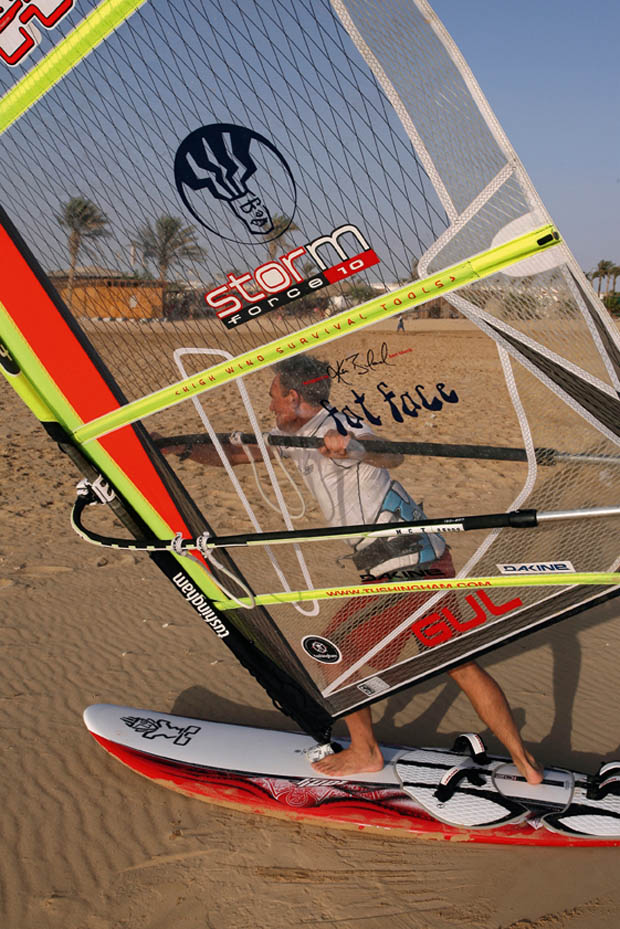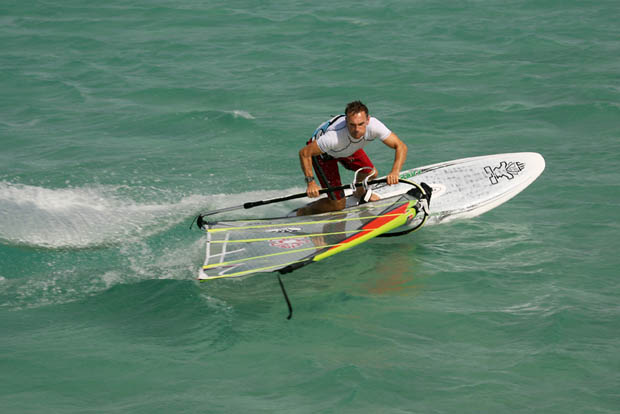
In this instalment of his comprehensive series examining every aspect of wavesailing, Jem Hall looks to inject your forward loops with a serious performance boost…
Let’s look at getting your forwards better by taking on board these top tips. They really will take your looping to another level – higher, cleaner, faster and more efficient with better landings.
There are now a lot of people of all ages and abilities out there looping. You need only check out the loop club thread on the forum or Clive ‘El Toro’ Boden’s movie on YouTube, amongst others. With all this trigger-pulling going on you can now look to improve your loops so that planing loops, one-handed loops or even doubles can all be within your grasp.
Let’s use the formula to kick off and then get down to my pearls of wisdom later:
Who? Forwarding better is for those of you getting all the way round and on your back but looking to get them cleaner. It’s also for those who drag half the sea with them and do vertical ‘pole vault style’ forwards. Your masts should not need a clean, so let’s tidy it up please ladies and gents so that they don’t touch the water.
Why? Getting your forwards faster and more efficient will allow you to go higher, initiate later and land more cleanly. Better technique will see you landing upright so that you can keep momentum and bag another brace of jumps on your way out.
What? A better forward comes from getting a good high jump while carrying some forward speed and then bearing away with the sail open. Getting the rig across and then scissoring the board off the wind will turn you downwind and put you in prime position to pull that trigger. Critically, it will help you do it efficiently by using your legs and your arms and not just by sheeting in and hoping for the best.
Where? As you gain a more proficient looping technique you can now loop off anything from 6-inch chop to head or logo-high waves. This means you can practise the move a whole lot more and get that awesome feeling coursing through your body much more often. Yippee!
When? Bearing away smoothly with the sail open and looping faster and cleaner means that you can initiate the actual loop a bit later, giving you that all-important time to get higher and get your forwards more delayed. The self-confidence you gain from looping cleaner gifts you the double whammy of actually feeling you have more time in the air before you whip a quick, clean rotation on your descent, as opposed to rotating as soon as you leave the wave.

SKYE HIGH
John Skye gives his take on all the tips we’ve mentioned above and adds a few more for good measure.
“I aim to keep forward speed even when going high. It seems if you go too vertical then it’s hard to get a good rotation. [Pole vaults suck I think he’s saying here. JH.] If I do go really vertical, then the trick is to bear away loads in the air and then try to gain some forward speed on the way down before initiating the rotation.”
So, when it all goes a bit Pete Tong John doesn’t just hope for the best and sheet in, he takes action. Back to John:
“Also, I have to really focus on sheeting out. It sounds wrong, but it’s really easy to go into the rotation too early at the top of the jump. Therefore, I focus on getting the rig really far forward – BUT sheeting the sail out at the same time. That way you continue to fly and can save the rotation until the last minute.”
I coached John back in ’02-’04 and we still mentor each other to this day. His forwards have improved by a country mile and he’s still looking to improve them every time he sails – he sets a new standard. His high competence in forwards and planing forwards meant he learnt to double with confidence and is happy to whip one out whenever he wants.
John Skye is sponsored by RRD Boards, Naish Sails, Xcel Wetsuits, and MFC Fins: 
Fast Forward
I went through the ‘no pain no gain’ learning curve of looping back in ’96, and boy did it hurt because I didn’t have all these tips, articles and movies to follow. My arse was… Well, you get the picture. Even though my loops were quite good, a couple of years back I decided to totally rebuild my forwards, and I’m still refining them today. I still go out and work on improving one small part of the move and tweaking technique – and I get to do this with the 150 or so I do a week to inspire clients on an advanced or looping coaching clinic and during demos. This means that these tips are fresh!
Kit Setup
The old chestnut of “That’s all right and this is what I’m used to” just won’t cut it here. In order for things to change you must change, and this begins before you leave the beach.
Footstraps: Yep, you guessed it, they need to be generous. When you feel your toes touching the deckpads and the windward rail flying high, it’s because your feet aren’t wrapped in some tortuous tourniquet masquerading as footstraps. Big is beautiful.
Boom height: Get it a decent height so you can plane early and fly high – and then get huge leverage to push down on it to drop the nose and rotate fast.
Harness lines: Long lines go hand-in-hand with a high boom (30” Flying Objects for me). We’ve all got different length arms, but if you measure from elbow in the loop to callous (end of palm) on the boom you’ll be in the right ballpark. This means you can sail with your front hand back and take off with your hands close together to get you higher. Short lines force hands wide with the front hand positioned forward on the boom, resulting in Duran Duran style sailing, shite stance, and no leverage on the boom. (Check the sailors with short lines and look how far forward their front hand is.) Lastly with the grip tips, please use an overhand grip for max leverage and downforce. Do you swim front crawl palms up? You will simply get your front arm straighter if it is overhand and this will get the rig further forward and in a better position.
Preparation:
Now your kit is set up right you can have your front hand at the front harness line. This is so you can go fast into take-off in ALL winds and then really pull the kit into the sky. With both hands slightly closer together the nose can lift a bit more, then the back hand can move back further in the aerial bearing away process, prior to trigger pulling.
So just before you take off choose a fast line with your hands shoulder-width apart and get low over the board. From your crouching tiger position actually pop the board off the wave / chop with your sail open so it’s already in a position to come across you for bearing away. The take-off can be more across the wind now because you WILL be getting better at aerial steering:

Aerial steering
After you’ve taken off and boosted some height you can begin to bear away in the air. With your front hand back on the boom and the rig already slightly across you, it’s easy to then slide your back hand down the boom to continue to move the rig across you. Note: no sheeting in yet, the rig is OPEN.
As the rig moves across this will help you steer the nose off the wind and then get the tail up through extending your front leg and pulling up and in with your back leg. The big straps get your windward rail high because your weight is more over your toeside rail, so the wind goes under it. The rig is forwards to keep up some momentum:

Ready, steady, go:
Just as in the pix you have the nose off, sail across, nose down and the sail open. You are now ready to pull the trigger. Those of you who’ve done lots of wymaroos will be feeling comfy here, so you might want to be doing more of these for your homework.
In order to pull the trigger here you push down hard on your straight front arm and pull in and UP on the back arm. The legs continue to get the nose down, but now more aggressively as you fully extend the front leg and feel the toes touch the deckpad. This front leg straight business will transform your forwards. It will get you rotating way faster and leave you landing more off the wind.
Assess your rotational speed and work the legs and arms harder to go faster OR sheet out a bit and bring the rig back while you move your arse back to slow you down. Whoosh! Now that was way faster.
Your timing will get better by doing more, and you just don’t know until you go:

Landing
With all your newfound rotational speed you’ll now be further round the loop and feel like you have more time to work on your landings. Aim to keep your legs scissored with back leg bent and in and front leg straight, as this will ensure you land more off the wind with more momentum and give you a cleaner getaway.
With your back hand way down the boom you can not only sheet in to rotate, but also sheet out for a softer landing. By letting out on your back hand with the sail slightly open you will oversheet the sail less and get some power back into it.
You can even think ‘mind the gap’ here as you look between the foot of the sail and the board’s deck to ensure you’ve sheeted out. This sheeting out to land on a downwind sailing line is de rigueur for maintaining momentum out of most jumps.
Whipping round a forward fast and then sheeting out to stop and readying yourself for a swift landing is the start of getting into planing forwards. So please take all of this into account:

Sum Up
There are plenty of great tips here, so go out and just work on one for about 3-5 loops and then reflect on what happened for you. Then work on another point. I promise you there will be some real lightbulb moments here.
If this is all too much then let’s just condense it down to: Get your hands back on the boom, steer in the air with your legs and the rig with the sail sheeted out, rotate fast and off the wind by working your arms and legs in a push-pull motion, and then sheet out to land off the wind. Do it, do it!

Hall’s Homework:
When you get some wind please work on high jumps and getting your tail up with some aerial steering and then float down. Wymaroos are definitely worth revisiting, and after this it’s pull that trigger, but with more efficiency, technique, speed – and after you have reached your apex. For those of you not looping YET set a date and pull that trigger. Lastly, get your one-handed jumps rocking and ready for the good old one-handed forward.






